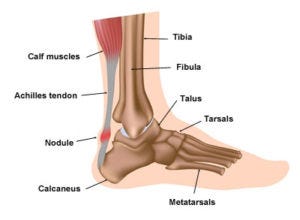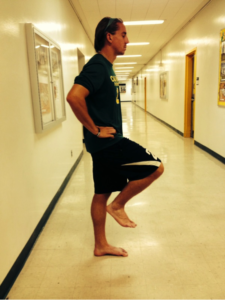After Climbing Standing on Ladder Pain Back of at Achilles Tendon
How To Beat Achilles Tendon Pain. The Best Exercises to Prevent It and Treat Fast If It Does Strike!
![]()
Achilles tendon pain gives you that sick feeling in the pit of your stomach. It usually happens when you feel invincible, when you have just passed a plateau and are posting the best running times of your season. But it also strikes when you buy new running shoes, skip that "rest day" because you were feeling so great or do an intense hill session when you were not used to it.
I am a physical therapist and triathlon coach and have spent years treating Achilles tendonitis in runners. The patterns are similar. It can be fixed but better yet- it can be prevented :)
Sometimes intense Achilles pain can appear out of the blue for no reason when you have not changed anything in your program.
Achilles tendon pain is felt in the back of your heel, in the Achilles tendon or in the lower calf.

"Oh well", you think, "a couple of days off running and I will be fine".
Sure enough, the opposite often happens, it gets worse and worse.
In the mornings when you get out of bed, you are literally limping with the pain. Some runners can actually manage to still run (though not advised) as when the tendon warms up, it becomes more elastic and the pain eases but it returns with intensity soon afterwards.
Achilles Tendonitis Warning Signs
Most runners keep running "hoping" the pain will go away. Unfortunately this is not a good strategy. It is imperative to rest from running. You can continue to swim, cycle and strength train. This is called dynamic rest. Only run if you are pain free. Training through pain only makes Achilles tendonitis worse and become more inflamed.
Do not continue to run through the pain, it will make it worse. As soon as you become aware of it, take a few days off, in many cases it will go away.
Treatment for Achilles Tendon Pain
If the pain is mild and you have noticed it early, the best thing to do is rest from 3 days to a week.
If the pain is medium intensity and causing you to limp, it is best to see a physical therapist, get some sports massage (to increase blood flow and elasticity in the tendon), ice it ( 2 x 10 minutes every evening) and do a program of strengthening exercises.
If the pain is severe, you will need to rest from running for 4–6 weeks. You will need intensive treatment on it. Your tendon is likely to be inflamed. Sometimes you will be able to feel a lump on the tendon. Once the inflammation has subsided, you will need a rehabilitation program of strengthening, stretching and have a gait analysis to improve your running mechanics.
Best Exercises for Achilles Tendon Pain
Strengthening is imperative and very effective. (Only do this if you are pain free)
Eccentric calf strengthening
Stand with your painful leg on the edge of a step. Lower down slowly then use both feet to push back up.
3 x 15 reps
Once this is easy, progress to single leg heel drops (surprisingly difficult!)
3 x 15 reps
One leg balance
Stand on one leg and balance for 45 seconds. Gradually try to improve your balance using your core. Start to relax the foot and calf as your balance improves.

Single knee bend
Most people skip this one and then find their Achilles problems return again and again.
Think about it: the single knee bend IS the running action. It is imperative this is correct.
Stand on one leg, bend your knee. Make sure your knee goes directly forward over your 3rd toe (not your big toe)
Repeat 3 x 15 reps. Make sure you are stable and not wobbling.
Gluteal and core strength work
Add in lunges, squats and core work to improve your lower limb strength and conditioning. This will help take the strain off your Achilles tendon. This video goes over the technique in the gym, but you can do body weight squats at home to being with- the same technique applies.
Achilles Tendon Rupture
However sometimes there is no warning sign. You may have no pain at all, then crossing the road or running to catch a cab, you have sudden excruciating pain in your Achilles area and fall to the ground. You feel like someone has hit you in the leg with a baseball bat.
Yes sadly, the Achilles tendon can rupture suddenly especially in very fit people.
It is most common in men aged 35–49 years old.
Remember Olympic hurdler Li Xiang
He was super fit and highly prepared but it happened on the biggest stage in the world.
Treatment for Achilles Tendon Rupture
Please read and implement the "prevention" section several times to make sure this does NOT happen to you but here is what happens if your Achilles ruptures.
You may get a partial Achilles tendon rupture. Your doctor/physical therapist may wait a few weeks to see if it heals by itself or with conservative treatment. You may be in plaster and on crutches.
If your Achilles tendon ruptures completely, you will require surgery to stitch it back together.
Recovery is not swift.
You will be in a cast for at least 6 weeks. Then you will require rehab and physical therapy for months to strengthen it correctly, mobilize it, and teach it to walk and then run again.
Most people are back running in 6–9 months.
How To Prevent Achilles Tendonitis
Prevention is by far the best and easiest way to avoid potentially major problems with Achilles tendon pain. It is far better to do 10 minutes stretches/exercises once or twice a week than have 6–8 weeks out of training or risk an Achilles rupture.
- Intelligently increase your distance and intensity
Many runners get impatient and make sudden increases in distance or time. Schedule your program then be disciplined enough to execute it. Very often tendonitis is caused by a sudden increase in load or force. If you do have a hard session(hills, intensity), no problem- but choose to rest the next day or swim or do a strength/core session the following day
2. Introduce changes gradually. Be careful with hill sessions, change of running shoes or change of terrain.
If you go from road running to off road- or vis versa- the altered terrain can cause tweaks in the Achilles tendon.
If you feel tweak or a strain, dial training back immediately. Do not try to push through. It is better to have one week off than try to be a hero and require 6 months off training due to injury. If you get new running shoes, ease back on distance and intensity for 7–10 days to allow your body to adjust.
3. Do warm up and cool down. This includes post training stretches
Yes its fun to be at training with everyone. Yes you are incredibly pushed for time. If you are honest, you probably rush straight from work, to the track, then with no warm up start running, sprinting, jumping, then finish your session, jump the car and drive home(promising your self you will do your stretches later- but never quite managing it). Ha ha! Do your stretches while waiting for your dinner to heat up. Do your stretches while relaxing watching the evening news or your latest Netflix season.

4. Do foam rolling. Calf muscles tend to get very tight.
Sometimes stretching is not enough to lengthen all the fibers.
I highly recommend bi-weekly foam rolling on your calf muscles to try to keep them from being tight and knotted.
Brittle calf muscles and Achilles tendons are far more likely to get injured.
5. Do weekly strength training, core training and agility work.
6. Have sports massage after a big training block.
Sports massage is amazing at preventing injuries. It enhances flexibility, improves blood flow in muscles and tendons and a can help heal little tweaks in muscles and tendons quickly before they become problems. Ideally you should have a sports massage every week. In reality, very few of us can make time for this. I personally get a sports massage once a month and I increase it to once a week if I have high volume training block or if I feel I am not recovering quickly enough or have any niggles.
7. Gait analysis
How you run is VERY important in the prevention and treatment of Achilles tendon pain. In most cases, runners with Achilles tendon pain have poor running mechanics. They over pronate, they have weak hip muscles and have very tight hamstrings and calf muscles.
Tips:
Get your gait analysed- VERY important. A sports therapist will video you on a treadmill and you will be amazed what you look like(especially in slow motion). You will also be amazed at all the ways you can improve.
Take the time to understand how to improve your running. Take some online coaching or grab a coach for a few weeks. This is the quickest way to prevent injury but also dramatically improve your running speed.
Two quick tips:
- Shorten your running stride
- Do not be a heel striker.. too much ground reaction force through the heel.
Summary
Achilles tendon pain is fairly common in runners and triathletes. As always, listen to your body. Do the important work that no one sees- strength training, stretches and foam rolling. Be intelligent enough to rest when you need to and you will reduce the risk of most injuries including the dreaded Achilles tendonitis.
Connect with me on twitter or facebook or get more awesome triathlon content at Triathlon-Hacks
After Climbing Standing on Ladder Pain Back of at Achilles Tendon
Source: https://medium.com/@DanGolding1/how-to-beat-achilles-tendon-pain-27e335e1676b
0 Response to "After Climbing Standing on Ladder Pain Back of at Achilles Tendon"
Post a Comment